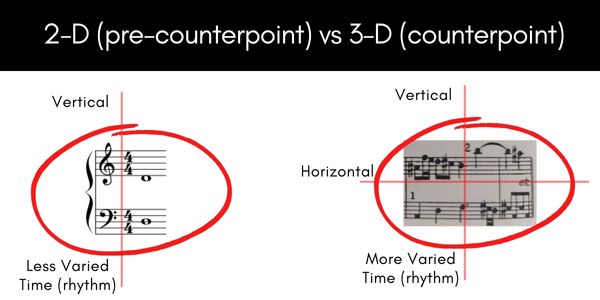During my undergraduate work, counterpoint happened to be one of my favorite topics in music theory (Who am I kidding? I liked them all!). I was a teacher’s assistant and graded many counterpoint exercises. What I saw was if students grasped the principles of counterpoint, they were more successful when we got to four-part writing, other composition techniques, and analysis.
Counterpoint is a horizontally layered approach to writing music. The music is based on a primary voice (line or melody). Other voices are added but are written with the intervallic relationship with the primary voice dictating what notes the other voices may use. The voices have independent melodic contours and rhythms.
There’s a lot that can be said about counterpoint, but here’s a quick round up of the main points.
Related articles
Who created counterpoint?
No one person created counterpoint. As with most theoretical writings, the music comes first then the theory. There’s certainly a who’s who list of theorists and composers who used counterpoint ideas in their music and/or explored writing down the principles of counterpoint. Instead of just listing a bunch of names, I thought it might be more interesting to list the names and influential works only if I could find an English translation for sale. It may be – dare I say – fun to read these works.
Early Influential theorists who wrote about counterpoint
- Prosdocimus de Beldemandis – Contrapunctus: Counterpoint: found a copy on AbeBooks. The translator is Jan W. Herlinger.
- Gioseffo Zarlino – The Art of Counterpoint: found a version published by W.W. Norton on AbeBooks.
- Johannes Tinctoris – The Art of Counterpoint (Liber De Arte Contrapuncti): found a copy on AbeBooks
- Johann Joseph Fux – Gradus Ad Parnassum: found basically everywhere!
All the masters learned counterpoint!
Though these composers didn’t create counterpoint, they certainly treated it seriously and reaped the benefits of its development. Basically every composer you’ve heard of learned counterpoint in some manner. Haydn, Mozart, Beethoven and many of the biggest names in classical music had extensive training in counterpoint. By the time these composers came around, counterpoint was pretty well established not only in music but theoretical and pedagogical writings.
Here is an example of where counterpoint went in the hands of Bach. He wrote this Fugue about 400 years after the first mention of contrapunctus in writings.
What is counterpoint?
At a fundamental level, counterpoint is simply considering the sonic relationships between two or more notes. Going a little deeper, counterpoint consists of two or more melodic lines that are interrelated to each other while rhythms and melodic contours are independent. Counterpoint is a sub-field of polyphony – polyphony being two or more independent musical lines. Counterpoint, whether Western classical, folk, or another tradition, is a more careful consideration of how each pitch relates vertically and horizontally. It is also the consideration that each line is a melody unto itself and fits in a woven texture with the whole. This is a slightly different angle than polyphony at large. Polyphony is more general in it’s definition of simply simultaneous voices.
What counterpoint isn’t
This could be a long list but let’s just go with, counterpoint is not monophony, homophony, or heterophony. Monophony is just a single line of music – think solo voice or violin. Homophony is where there is a melody that is supported by chords – think most pop songs. Heterophony is the simultaneous performance of the same melodic line by different instruments or voices. Counterpoint’s definition does not fit any of those.
When did counterpoint start?
Counterpoint, like other movements in the arts, is a continuum, not a one time event. Precursors to what is now considered counterpoint were in full swing toward the end of the Medieval period and many pieces were counterpoint in all but name. There are key texts that help us place when the concept of counterpoint began to become more concrete. The word contrapunctus is seen in a number of writing since the 1300s. But authorship among these earliest of writings is debated. By 1412 the Italian theorist Prosdocimus de Beldemandis wrote a Treatis of Counterpoint which clearly showed the development of the theory. At this point counterpoint was no longer only concerned with “note against note” but melodic line against melodic line.
The 15th century ushered in a golden age of polyphony (counterpoint), with Guillaume Dufay (1400–1474), Josquin des Prez (c. 1450–1521), and Giovanni Pierluigi da Palestrina (c. 1525–1594) just to name a few. Johannes Tinctoris (c. 1435 – 1511) wrote Liber De Arte Contrapuncti which went into intervals, consonance and dissonance, and their usage. In this book he put down strict rules for introducing dissonances, limiting them to unstressed beats and syncopations – all of which contributed to the codification of counterpoint.
Though many theorists wrote about counterpoint during the 1600s, it wasn’t until Johann Joseph Fux wrote Gradus ad Parnassum in 1725 that counterpoint had it’s “official” text book. This became the definitive pedagogical work for counterpoint. Though there are plenty of counterpoint text books available today, 300 years later, Gradus ad Parnassum continues to provide a clear way for students to learn this method of composition.
Where did counterpoint start?
Primarily in France and Italy. Counterpoint grabbed hold at the end of the musical period called Ars Nova (late 1300s and 1400s) which is the commonly accepted transition between the music of the Middle Ages and the Renaissance periods in Europe.
Why learn counterpoint
Counterpoint is an important piece of musical knowledge and understanding
In Alfred Mann’s translation of Gradus ad Parnassum, the monumental work by Johann Joseph Fux, he begins by says, “The Study of Counterpoint might be compared to the study of perspective. Bother we important developments in Renaissance art. Both reflect the rise of three-dimensional thought.” Counterpoint is the rise of three-dimensional thought. Before counterpoint was in common use or written down into a system, a medieval composer conceived of music as two-dimensional – strictly note against note. This means medieval composers viewed their craft note to note moment by moment. Whereas later polyphonic composers of the renaissance period began to judge an entire melody against another entire melody. The three dimensions of counterpoint are the vertical and horizontal relationships, and time (rhythm). More importantly, it’s the long-range horizontal composition of entire melodic lines while keeping in mind how they relate to the other lines in the piece of music at the scale of the entire piece.

After about 1300, the word counterpoint started to emerge. And by 1412 the music and theoretical writing on counterpoint we well underway. Part of what makes counterpoint so important for all types of musicians is how it codified an important shift in Western music. As art “discovered” perspective, music “discovered” a new awareness of the distance of time.
Counterpoint became a teaching tool with Fux’s influential book. It is a great way to learn about intervals, voice leading, consonance, dissonance, how to control multiple lines of music, melodic shaping, and more! Typically, a student of music must learn counterpoint and harmony. In order to understand how the underlying principles of harmony were determined and used, one must understand the counterpoint.
For composers, counterpoint teaches discipline and care all the while showing students that there are many “right” answers and when in doubt to use their ears.
For performers, understanding counterpoint helps bring out the subtilties in music from the renaissance on. Knowing more about the whys and how’s of interweaving musical lines can help performers make musical decisions that enhance the performance.

Leave a Reply